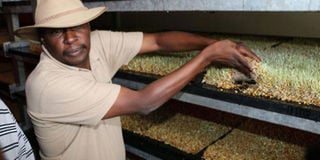Grow fodder in six days and feed cows on the seventh

Mr Charles Ndegwa tends to his hydroponics crops at his farm in Kiambu. PHOTO | GAKIHA WERU | NATION MEDIA GROUP
What you need to know:
- I took my time to look for alternative methods that farmers in developed countries use to feed their animals during droughts. What do they do differently to increase and sustain milk, meat and egg production without increasing costs? I asked myself.
- In Australia, I discovered, they started using hydroponic fodder in 1940s. By the 1970s, other countries like India, Canada, America and South Africa had adopted it to feed their animals.
- Hydroponics is a fusion of the old and the new. It was practised in older civilisations in Egypt, Mexico and China. However, it has been under constant research and improvement over the years.
My name is Charles Ndegwa. I had chosen a training path that would have ended in a career in radio frequency engineering.
As matter of fact, pursuit for training in engineering had taken me to distant Finland.
It didn’t quite turn out that way for me and today I’m a researcher in hydroponic technologies all geared towards making the lives of farmers more profitable and easier.
Hydroponics, a subset of hydroculture, is a method of growing plants using mineral nutrient solutions, in water, without soil.
But there is a good reason for this shift in my career path. I’m very much my father’s son. I spent many years at the feet of my late father, Charles Ndegwa, the National Agricultural Research Laboratories/Kari researcher who engineered the nationally acclaimed 614 maize seed.
From my father, I learnt the importance of research as a means to greater food production, greater returns and higher standards of living.
After working in the ICT industry for a while, I got a job at Agrotunnel International Ltd as a researcher. A few years ago, one of the directors at Agrotunnel, Faridah Marete, attended an agribusiness course at USIU sponsored by Melinda Gates.
The course exposed to her the pain of dairy farmers who struggled to increase production without reducing their profit margins. She saw a business opportunity and challenged me to find a solution to farmers’ fodder problems.
I took my time to look for alternative methods that farmers in developed countries use to feed their animals during droughts. What do they do differently to increase and sustain milk, meat and egg production without increasing costs? I asked myself.
In Australia, I discovered, they started using hydroponic fodder in 1940s. By the 1970s, other countries like India, Canada, America and South Africa had adopted it to feed their animals.
Farmers in those countries have increased milk and meat production and also slashed their production costs. Hydroponics require only water and grain. No fertilizers are used.
I was convinced that hydroponics is what we were looking for. To effectively venture into this line of work and research, we formed Fodder Grow as a subsidiary of Agrotunnel International. We brought together five directors.
Hydroponics allows farmers to grow fodder in a record six days. It drastically reduces the time a farmer spends looking for fodder and increases milk production. It is ideal for small and large-scale farmers. It is also important in rearing chickens.
COMMONLY USED
Hydroponics is a fusion of the old and the new. It was practised in older civilisations in Egypt, Mexico and China. However, it has been under constant research and improvement over the years.
Cereals such as sorghum, rice, maize and sim sim are some the mostly commonly used seed for hydroponic productions. Under proper production guidelines, the fodder matures in just six days — hence giving the farmer easy access to animal feed.
On day one, for instance, dry barley grains come in contact with water in trays and swells. On day two, the grain bursts and roots sprout followed by a shoot on day three. On day four, the shoot continues to grow and at this stage, this fodder can be fed to chickens. The green fodder grows further on day five and six and on day seven, it can be fed to livestock.
The most suitable material for hydroponics is aluminium trays. Some small-scale farmer have been improvising and using such materials as cold galvanised steel trays or greenhouse polythene.
What many forget or don’t know is that galvanised iron rusts when it comes into contact with water. This poses several health hazards when consumed by animals. Polythene is also a breeding ground for mould and consequently, aflatoxin which can kill animals. Aflatoxin-contaminated milk and meat are also toxic to humans.
At a cost of Sh100,000, we can put up a unit capable of producing 50kgs of fodder a day. This is enough to feed five cows on a small holding. We can use local materials to make a small unit to produce 20kg of fodder at a cost of Sh50,000.
We have put up units in Nakuru, Kajiado and Kiambu counties. The unit in Kiambu produces a tonne of fodder a day while the one in Nakuru produces three tonnes a day, which is enough to feed 300 cows.
Through Agrotunnel International, we have now working with Egerton and Makerere universities to equip farmers with the skills for fodder production. We have trained farmers and government officials from Zimbabwe, Malawi, Uganda, Tanzania, Zambia, Nigeria and Ethiopia.
We are currently recruiting for fodder production training in South Africa before the end of November.




